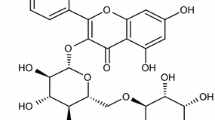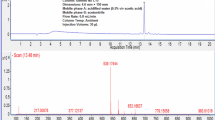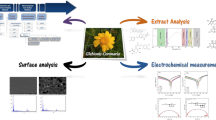Abstract
In this study, we explored aluminum corrosion inhibition field of study in a 1 M HCl solution, harnessing the power of essential oils extracted from rosemary and eucalyptus plants. Our exploration gives a comprehensive analysis of the pivotal factors that shape the corrosion inhibition process. Our scientific journey was marked by a deliberate and systematic approach, encompassing the utilization of gravimetric analysis (weight loss), electrochemical potentiodynamic polarization, and the sophisticated electrochemical impedance spectrometry (EIS) techniques. Our findings unveiled promising and nuanced outcomes, particularly in the area of the electrochemical technique. This method demonstrated remarkable inhibition efficiencies, ranging from 42% to an impressive 92% for rosemary essential oil and from 37 to 84% for eucalyptus essential oil. These results unveiled a dynamic relationship between essential oil concentration and inhibition efficiency, a revelation that further deepens our understanding of the corrosion inhibition process. The inhibition efficiency increased with higher concentrations of essential oil but decreased with elevated temperatures. Furthermore, our analysis traversed into the realms of potentiodynamic and thermodynamic insights. These analytical techniques unearthed the complex mechanisms at play, explaining the pathway followed by the studied inhibitors. They exhibited their prowess by forming protective films on the metal surface, acting as vigilant protectors against the relentless forces of corrosion. Complementing our experimental findings, our study of computational chemistry through density functional theory (DFT) unveiled remarkable insights. It elucidated the spontaneous adsorption process of inhibitor molecules onto the aluminum surface in the presence of H2O solvent. This computational harmony with our experimental results strengthened our confidence in the robustness of our findings. One of the key findings of this study was the superior inhibitory power of camphor in rosemary EO and β-myrcene in eucalyptus essential oil EO, respectively, attributed to the distinctive characteristics of the active sites found in each compound. The inhibitory effectiveness followed the order β-myrcene > camphor > borneol > α-pinene > bornyl acetate > p-cymene > 1,8-cineole. These compounds, notable for their distinct active sites, emerged as exceptional agents in the pursuit of effective corrosion inhibition.























Similar content being viewed by others
Data availability
The data sets used and/or analyzed during this study are available from the corresponding author upon reasonable request.
References
Adamu M, Umoru LE, Ige OO (2014) Effect of toluene and dioctylphthalate on the rebar corrosion of medium carbon steel in seawater and cassava fluid. JMMCE 02:1–7. https://doi.org/10.4236/jmmce.2014.21001
Akkermans RLC, Spenley NA, Robertson SH (2013) Monte Carlo methods in materials studio. Mol Simul 39:1153–1164. https://doi.org/10.1080/08927022.2013.843775
Al Jahdaly B (2023) Rosmarinus officinalis extract as eco-friendly corrosion inhibitor for copper in 1 M nitric acid solution: experimental and theoretical studies. Arab J Chem 16–1:104411. https://doi.org/10.1016/j.arabjc.2022.104411
Asadi N, Ramezanzadeh M, Bahlakeh G, Ramezanzadeh B (2019) Utilizing lemon balm extract as an effective green corrosion inhibitor for mild steel in 1M HCl solution: a detailed experimental, molecular dynamics, Monte Carlo and quantum mechanics study. J Taiwan Inst Chem Eng 95:252–272. https://doi.org/10.1016/j.jtice.2018.07.011
Ashassi-Sorkhabi H, Shabani B, Aligholipour B, Seifzadeh D (2006) The effect of some Schiff bases on the corrosion of aluminum in hydrochloric acid solution. Appl Surf Sci 252:4039–4047. https://doi.org/10.1016/j.apsusc.2005.02.148
Balakrishnan T, Sathiyanarayanan S, Mayavan S (2015) Advanced anticorrosion coating materials derived from sunflower oil with bifunctional properties. ACS Appl Mater Interfaces 7:19781–19788. https://doi.org/10.1021/acsami.5b05789
Belakhdar A, Ferkous H, Djellali S, Sahraoui R, Lahbib H, Ben Amor Y, Erto A, Balsamo M, Benguerba Y (2020) Computational and experimental studies on the efficiency of Rosmarinus officinalis polyphenols as green corrosion inhibitors for XC48 steel in acidic medium. Colloids Surf, A 606:125458. https://doi.org/10.1016/j.colsurfa.2020.125458
Belghiti ME, Echihi S, Mahsoune A et al (2018) Piperine derivatives as green corrosion inhibitors on iron surface; DFT, Monte Carlo dynamics study and complexation modes. J Mol Liq 261:62–75. https://doi.org/10.1016/j.molliq.2018.03.127
Benabdallah A, Betina S, Bouchentouf S, Boumendjel M, Bechkri S, Bensouici C, Nicoli F, Vergine M, Negro C, De Bellis L (2022) Chemical profiling, antioxidant, enzyme inhibitory and in silico modeling of Rosmarinus officinalis L. and Artemisia herba-alba Asso. essential oils from Algeria. S Afr J Bot 147:501–510. https://doi.org/10.1016/j.sajb.2022.02.012
Chafi M, Byadi S, Barhoumi A et al (2022) Study of copper removal by modified biomaterials using the response surface methodology, DFT calculation, and molecular dynamic simulation. J Mol Liq 363:119799. https://doi.org/10.1016/j.molliq.2022.119799
Chamorro E, Pérez P, Domingo LR (2013) On the nature of Parr functions to predict the most reactive sites along organic polar reactions. Chem Phys Lett 582:141–143. https://doi.org/10.1016/j.cplett.2013.07.020
Chauhan DS, Quraishi MA, Qurashi A (2021) Recent trends in environmentally sustainable Sweet corrosion inhibitors. J Mol Liq 326:115117. https://doi.org/10.1016/j.molliq.2020.115117
Costa D, Marcus P (2015) Adsorption of organic inhibitor molecules on metal and oxidized surfaces studied by atomistic theoretical methods. Mol Model Corros Process Sci Dev Eng Appl, pp 125–156. https://doi.org/10.1002/9781119057666.ch5
Dehghani A, Ramezanzadeh B (2023) Rosemary extract inhibitive behavior against mild steel corrosion in tempered 1 M HCl media. Ind Crops Prod 193:116183. https://doi.org/10.1016/j.indcrop.2022.116183
Dhouibi I, Masmoudi F, Bouaziz M, Masmoudi M (2021) A study of the anti-corrosive effects of essential oils of rosemary and myrtle for copper corrosion in chloride media. Arab J Chem 14(2):102961. https://doi.org/10.1016/j.arabjc.2020.102961
Domingo LR, Pérez P, Sáez JA (2013) Understanding the local reactivity in polar organic reactions through electrophilic and nucleophilic Parr functions. RSC Adv 3:1486–1494. https://doi.org/10.1039/C2RA22886F
Eddy NO, Odoemelam SA, Odiongenyi AO (2009) Inhibitive, adsorption and synergistic studies on ethanol extract of Gnetum Africana as green corrosion inhibitor for mild steel in H2SO4. Green Chem Lett Rev 2:111–119. https://doi.org/10.1080/17518250903170868
Eddy NO, Odoemelam SA, Ogoko EC et al (2022) Experimental and quantum chemical studies of synergistic enhancement of the corrosion inhibition efficiency of ethanol extract of Carica papaya peel for aluminum in solution of HCl. Results Chem 4:100290. https://doi.org/10.1016/j.rechem.2022.100290
EL Mazyani A, Chafi M, Essahli M (2021) Assessment of AA5005 aluminum alloy corrosion resistance by Direct Blue 15 inhibitor in sodium chloride medium. Mater Today: Proc 37:3882–3888. https://doi.org/10.1016/j.matpr.2020.08.473
El Ouariachi E, Paolini J, Bouklah M, Elidrissi A, Bouyanzer A, Hammouti B, Desjobert J-M (2010) Adsorption properties of Rosmarinus officinalis oil as green corrosion inhibitors on C38 steel in 0.5 M H2SO4. Costa J Acta Metall Sin (Engl Lett) 23–1:13–20. https://doi.org/10.11890/1006-7191-101-13
Fayomi OSI, Akande IG, Odigie S (2019) Economic impact of corrosion in oil sectors and prevention: an overview. J Phys: Conf Ser 1378:022037. https://doi.org/10.1088/1742-6596/1378/2/022037
Fazal BR, Becker T, Kinsella B, Lepkova K (2022) A review of plant extracts as green corrosion inhibitors for CO2 corrosion of carbon steel. npj Mater Degrad 6:5. https://doi.org/10.1038/s41529-021-00201-5
Frisch MJEA, Trucks GW, Schlegel HB, Scuseria GE, Robb MA, Cheeseman JR, Scalmani G, Barone V, Mennucci B, Petersson GA, Nakatsuji H, Caricato M, Li X, Hratchian HP, Izmaylov AF, Bloino J, Zheng G, Sonnenberg JL, Hada M, Ehara M, Toyota K, Fukuda R, Hasegawa J, Ishida M, Nakajima T, Honda Y, Kitao O, Nakai H, Vreven T, Montgomery JA Jr, Peralta JE, Ogliaro F, Bearpark M, Heyd JJ, Brothers E, Kudin KN, Staroverov VN, Kobayashi R, Normand J, Raghavachari K, Rendell A, Burant JC, Iyengar SS, Tomasi J, Cossi M, Rega N, Millam JM, Klene M, Knox JE, Cross JB, Bakken V, Adamo C, Jaramillo J, Gomperts R, Stratmann RE, Yazyev O, Austin AJ, Cammi R, Pomelli C, Ochterski JW, Martin RL, Morokuma K, Zakrzewski VG, Voth GA, Salvador P, Dannenberg JJ, Dapprich S, Daniels AD, Farkas Ö, Foresman JB, Ortiz JV, Cioslowski J, Fox DJ, Nakatsuji H (2009) Gaussian 09, revision a. 02; Gaussian, Inc.: Wallingford, CT. 20
Gece G (2008) The use of quantum chemical methods in corrosion inhibitor studies. Corros Sci 50:2981–2992. https://doi.org/10.1016/j.corsci.2008.08.043
Ghalib L, Al Jaaf HJM, Abdulghani HA (2021) Temperature effect on the efficiency of Eucalyptus camaldulensis leaves in the acid corrosion of carbon steel. Mater Today: Proc 42:2475–2481. https://doi.org/10.1016/j.matpr.2020.12.566
Gopalakrishnan V, Balasubramanian A, Subramanian L et al (2023) Experimental and theoretical analysis on mild steel corrosion inhibition by two novel compounds (FD and ACP) in acidic media. Port Electrochim Acta 41:223–246. https://doi.org/10.4152/pea.2023410304
Hamani H, Douadi T, Al-Noaimi M et al (2014) Electrochemical and quantum chemical studies of some azomethine compounds as corrosion inhibitors for mild steel in 1M hydrochloric acid. Corros Sci 88:234–245. https://doi.org/10.1016/j.corsci.2014.07.044
Hsissou R, Abbout S, Seghiri R et al (2020) Evaluation of corrosion inhibition performance of phosphorus polymer for carbon steel in [1 M] HCl: computational studies (DFT, MC and MD simulations). J Market Res 9:2691–2703. https://doi.org/10.1016/j.jmrt.2020.01.002
John S, Joy J, Prajila M, Joseph A (2011) Electrochemical, quantum chemical, and molecular dynamics studies on the interaction of 4-amino-4H,3,5-di(methoxy)-1,2,4-triazole (ATD), BATD, and DBATD on copper metal in 1N H2SO4. Mater Corros 62:1031–1041. https://doi.org/10.1002/maco.201005938
Kumar H, Yadav V, Kumari A (2022) Adsorption, corrosion inhibition mechanism, and computational studies of Azadirachta indica extract for protecting mild steel: sustainable and green approach. J Phys Chem Solids 165:110690. https://doi.org/10.1016/j.jpcs.2022.110690
Li X, Deng S, **e X (2014) Experimental and theoretical study on corrosion inhibition of oxime compounds for aluminium in HCl solution. Corros Sci 81:162–175. https://doi.org/10.1016/j.corsci.2013.12.021
Loto RT (2020) Evaluation of the corrosion inhibition effect of the combined admixture of rosemary and cinnamon cassia oil on mild steel in weak acid electrolyte. Sustain Chem Pharm 17:100298. https://doi.org/10.1016/j.scp.2020.100298
Lukovits I, Kálmán E, Zucchi F (2001) Corrosion inhibitors—correlation between electronic structure and efficiency. Corrosion 57:3–8. https://doi.org/10.5006/1.3290328
Maatouf N, Lumaret J-P (2012) Eco-éthologie des nouveaux ravageurs invasifs des eucalyptus du Maroc. Annales De La Société Entomologique De France (NS) 48:289–297. https://doi.org/10.1080/00379271.2012.10697778
Mouden OIE, Ahmed B, Bammou L et al (2021) Zygophyllum qatarense extract as corrosion inhibitor for mild steel in acidic medium. Appl J Environ Eng Sci 7:7–124. https://doi.org/10.48422/IMIST.PRSM/ajees-v7i1.25727
Mouloudi M (2021) Study of corrosion pit propagation in aluminum by numerical simulation using the finite element method. Int J Electrochem Sci 21119. https://doi.org/10.20964/2021.11.24
Mouloudi M (2022) Numerical study of aluminum pitting corrosion using a two- dimensional multi-species transport model. Int J Electrochem Sci 221286. https://doi.org/10.20964/2022.12.77
Mounich K, Chafi M, El Hachemi OL, Tizliouine A, Wahabi W (2023) Study and conception of a potentiostat at competitive prices and its application for assessing aluminum corrosion inhibition. J Port Electrochem Soc 1185–22:71–91. https://doi.org/10.4152/pea.2024420105
Napoli EM, Curcuruto G, Ruberto G (2010) Screening of the essential oil composition of wild Sicilian rosemary. Biochem Syst Ecol 38:659–670. https://doi.org/10.1016/j.bse.2010.04.001
Narayanasamy B, Rajendran S (2010) Electropolymerized bilayer coatings of polyaniline and poly(N-methylaniline) on mild steel and their corrosion protection performance. Prog Org Coatings 67:246–254. https://doi.org/10.1016/j.porgcoat.2009.12.001
Nnaji N, Sen P, Nyokong T (2022) Symmetry effect of cobalt phthalocyanines on the aluminium corrosion inhibition in hydrochloric acid. Mater Lett 306:130892. https://doi.org/10.1016/j.matlet.2021.130892
Noor EA, Al-Moubaraki AH (2008) Thermodynamic study of metal corrosion and inhibitor adsorption processes in mild steel/1-methyl-4[4′(-X)-styryl pyridinium iodides/hydrochloric acid systems. Mater Chem Phys 110:145–154. https://doi.org/10.1016/j.matchemphys.2008.01.028
Obot IB, Macdonald DD, Gasem ZM (2015) Density functional theory (DFT) as a powerful tool for designing new organic corrosion inhibitors. Part 1: an overview. Corros Sci 99:1–30. https://doi.org/10.1016/j.corsci.2015.01.037
Obot IB, Kaya S, Kaya C, Tüzün B (2016) Density functional theory (DFT) modeling and Monte Carlo simulation assessment of inhibition performance of some carbohydrazide Schiff bases for steel corrosion. Physica E 80:82–90. https://doi.org/10.1016/j.physe.2016.01.024
Okafor PC, Ebenso EE, Ekpe UJ (2010) Azadirachta indica extracts as corrosion inhibitor for mild steel in acid medium. Int J Electrochem Sci 5–7:978–993. https://doi.org/10.1016/S1452-3981(23)15337-5
Parr RG, Pearson RG (1983) Absolute hardness: companion parameter to absolute electronegativity. J Am Chem Soc 105:7512–7516. https://doi.org/10.1021/ja00364a005
Parr RG, Szentpály LV, Liu S (1999) Electrophilicity index. J Am Chem Soc 121:1922–1924. https://doi.org/10.1021/ja983494x
Pearson RG (1988) Absolute electronegativity and hardness: application to inorganic chemistry. Inorg Chem 27:734–740. https://doi.org/10.1021/ic00277a030
Qiang Y, Zhang S, Xu S, Li W (2016) Experimental and theoretical studies on the corrosion inhibition of copper by two indazole derivatives in 3.0% NaCl solution. J Colloid Interface Sci 472:52–59. https://doi.org/10.1016/j.jcis.2016.03.023
Quebbou Z, Chafi M, Omari LEH (2021) Corrosion resistance of 5005 aluminum alloy by anodizing treatment in a mixture of phosphoric and boric acids. Mater Today: Proc 37:3854–3859. https://doi.org/10.1016/j.matpr.2020.08.406
Sabbahi M, Tahani A, Talhaoui A, El-Bachiri A (2023) Cartography and chemical profiling of rosemary essential oil in Eastern High Atlas Mountains, Morocco. Mater Today: Proc 72–7:3435–3441. https://doi.org/10.1016/j.matpr.2022.08.087
Saha SK, Dutta A, Ghosh P et al (2015) Adsorption and corrosion inhibition effect of Schiff base molecules on the mild steel surface in 1 M HCl medium: a combined experimental and theoretical approach. Phys Chem Chem Phys 17:5679–5690. https://doi.org/10.1039/C4CP05614K
Sastri VS, Perumareddi JR (1997) Molecular orbital theoretical studies of some organic corrosion inhibitors. Corros Sci 53:617–622. https://doi.org/10.5006/1.3290294
Şeker S, Çakaloğulları U, Bayram E, Tatar Ö (2023) Production of sage, oregano and rosemary under shading conditions and the effects of light on growth and essential oil properties. Ind Crops Prod 193:116254. https://doi.org/10.1016/j.indcrop.2023.116254
Selmi S, Rtibi K, Grami D, Sebai H, Marzouki L (2017) Rosemary (Rosmarinus officinalis) essential oil components exhibit anti-hyperglycemic, anti-hyperlipidemic and antioxidant effects in experimental diabetes. Pathophysiology 24–4:297–303. https://doi.org/10.1016/j.pathophys.2017.08.002
Sparkman OD (2005) Identification of essential oil components by gas chromatography/quadrupole mass spectroscopy Robert P. Adams. J Am Soc Mass Spectrom 16:1902–1903. https://doi.org/10.1016/j.jasms.2005.07.008
Tabatabaei Majd M, Bahlakeh G, Dehghani A et al (2019) Combined molecular simulation, DFT computation and electrochemical studies of the mild steel corrosion protection against NaCl solution using aqueous eucalyptus leaves extract molecules linked with zinc ions. J Mol Liq 294:111550. https://doi.org/10.1016/j.molliq.2019.111550
Tang Y, Yang X, Yang W et al (2010) A preliminary investigation of corrosion inhibition of mild steel in 0.5M H2SO4 by 2-amino-5-(n-pyridyl)-1,3,4-thiadiazole: polarization, EIS and molecular dynamics simulations. Corros Sci 52:1801–1808. https://doi.org/10.1016/j.corsci.2010.01.028
Wang D, Yang D, Zhang D et al (2015) Electrochemical and DFT studies of quinoline derivatives on corrosion inhibition of AA5052 aluminium alloy in NaCl solution. Appl Surf Sci 357:2176–2183. https://doi.org/10.1016/j.apsusc.2015.09.206
Wang J, Zhao J, Tabish M et al (2023) Long-term corrosion inhibition for AA5052 aluminum alloy by an eco-friendly hybrid inhibitor: synergism inhibition between rosemary extract and zinc chloride in 0.05 M NaCl solution. J Ind Eng Chem 120:302–315. https://doi.org/10.1016/j.jiec.2022.12.037
Yanai T, Tew DP, Handy NC (2004) A new hybrid exchange–correlation functional using the Coulomb-attenuating method (CAM-B3LYP). Chem Phys Lett 393:51–57. https://doi.org/10.1016/j.cplett.2004.06.011
Zhang Q, Hua Y (2010) Corrosion inhibition of aluminum in hydrochloric acid solution by alkylimidazolium ionic liquids. Mater Chem Phys 119:57–64. https://doi.org/10.1016/j.matchemphys.2009.07.035
Acknowledgements
The authors would like to acknowledge the support of the Hassan II University of Casablanca for the technical help.
Author information
Authors and Affiliations
Contributions
This work is the result of collaboration among all authors. Fathia Laihemdi: conceptualization, data collection, and writing original draft; Ali Barhoumi: conceptualization, draw figures, writing, methodology, and investigation. Meryem Zarri: conceptualization, draw figures, methodology, and investigation. Mohamed Tahiri: formal analysis and validation. Mohammed Chafi: methodology, formal analysis, writing, validation, review, and editing. All authors approved the final manuscript.
Corresponding author
Ethics declarations
Ethical approval
This manuscript was prepared in accordance with ethical standards: not contain any studies with human participants or animals performed by any of the authors.
Consent to participate
The authors have voluntarily agreed to participate in this research study.
Consent for publication
All authors hereby consent to publish this manuscript in Environmental Science and Pollution Research.
Competing interests
The authors declare no competing interests.
Disclaimer
The authors state that no financial relationship connects them with individuals or organizations that can influence the results of their work. The work presented is the result of a purely scientific effort.
Additional information
Responsible Editor: Philippe Garrigues
Publisher's Note
Springer Nature remains neutral with regard to jurisdictional claims in published maps and institutional affiliations.
Rights and permissions
Springer Nature or its licensor (e.g. a society or other partner) holds exclusive rights to this article under a publishing agreement with the author(s) or other rightsholder(s); author self-archiving of the accepted manuscript version of this article is solely governed by the terms of such publishing agreement and applicable law.
About this article
Cite this article
Laihemdi, F., Barhoumi, A., Zarri, M. et al. Inhibition of corrosion of an aluminum alloy by rosemary and eucalyptus extracted oils in 1 M hydrochloric acid medium: an experimental and theoretical study. Environ Sci Pollut Res (2023). https://doi.org/10.1007/s11356-023-30800-5
Received:
Accepted:
Published:
DOI: https://doi.org/10.1007/s11356-023-30800-5




